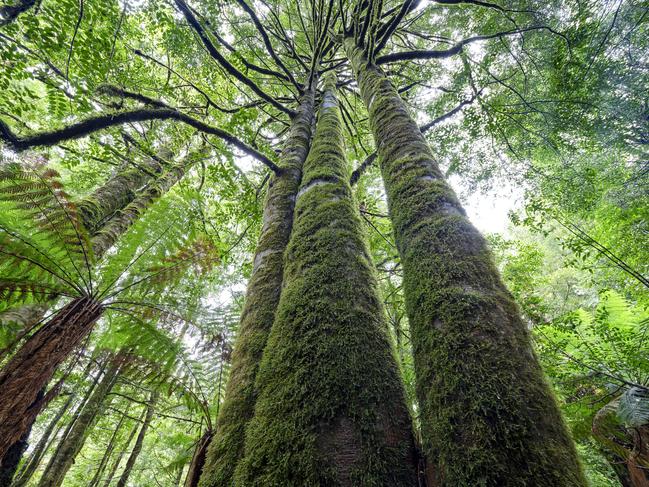Talking Point: State forester Sustainable Timber Tasmania delivers a massive $1.3bn loss
After doing the sums, an economist says any hint the government-run Sustainable Timbers Tasmania is economically sustainable, as its name suggests, is utter nonsense. SEE WHY >>
Opinion
Don't miss out on the headlines from Opinion. Followed categories will be added to My News.
WHETHER or not we have a native forest industry and on what scale won’t be determined by economic sustainability.
Tassie’s AFL side will be playing away games on Mars before that occurs.
Yet the industry still pretends it is sustainable, judging by Nick Steel from the Tasmanian Forest Products Association (Talking Point, April 10).
In the 20 years of the Regional Forest Agreement (RFA) until 2017, the publicly owned Sustainable Timber Tasmania (STT) incurred cash deficits of $562m, including operating losses plus all the money spent on roads and plantations that failed to increase its assets base and are therefore expenses just like wages. Over the same period the value of native forests fell $752m, and it suffered a huge increase in superannuation liabilities, which the government took over in 2017.
These balance sheet losses of $840m took overall losses over a 20-year period to $1.3bn.
Let’s have no more of the nonsense that our native forest industry is sustainable
The cash losses were financed by government handouts plus the sale of almost all STT’s plantations.
The entire softwood estate was sold in two tranches for $133m and 30,000ha of hardwood plantations financed by governments to build a more sustainable STT were sold below cost for $60m.
When STT values its forest estate it estimates future harvest proceeds and then deducts harvest and cartage costs and holding costs until harvest. But it does not include roads to harvest or replanting costs, which are mandatory. Were it to do so, native forests would have nil value.

Clear-felling a native forest coupe may raise cash but that doesn’t mean it is profitable or sustainable, especially if you exclude the costs of access and replanting. Felling native forests is a cashing event not a profit-making exercise.
Imagine for a moment you inherited a shed full of Queen Anne furniture. Selling pieces for firewood might raise cash but that does not make it profitable or sustainable.
Sustainable Timber Tasmania regards forest land as worthless. That’s what its financial statements indicate.
Hence when a coupe is harvested the land value does not change. It remains at zero. The losses of non-forest values are ignored. Forestry roads have a larger value than the land upon which they are constructed. It’s absurd.
Cherry-picking future costs to be included when valuing a forest, attributing a nil value to forest land and failing to recognise the loss of non-forest values at harvest time all combine to reach the erroneous conclusions that native forest logging is sustainable.
The industry is quick to say its losses are compounded by the fact some production forests have been locked up. There’s a possible element of truth here but on the other hand most evidence suggests if more forests were logged, then losses would be even greater.
Another argument made by the forest industry is to assert the benefits that flow from the fruits of harvesting. This is true to a certain extent but is true of almost all economic activity. Federal Hotels justify picking the pockets of disadvantaged pokie players by asserting the value added to the economy. Costs borne by players are conveniently ignored. It’s not a template we should follow.

There’s a lot of spillover costs from the forest industry, just ask Blue Derby Mountain Bike operators who run the risk that STT’s activities will scar the very landscape which make their neck of the woods a world class mountain biking venue or grape growers who constantly hope smoke from one of STT’s fires doesn’t spoil their crops. These spillover costs are in addition to the loss of non-forest values that attach to watercourse, species and habitat preservation each time coupes are clear-felled.
Native forest logging as done by STT is unsustainable and will become more so as coupes are increasingly remote with many only logged to fulfil contractual arrangements gifted to Ta Ann Tasmania in expectation more value could be added to timber otherwise destined for the woodchip pile. We were misled. Forests are being felled before time specifically to meet Ta Ann’s needs, with proceeds little more than from woodchipping.
So let’s have no more of the nonsense that our native forest industry is sustainable. Some producers of native forest timber products may be sustainable but only if STT continues its loss making, maintaining the tradition of subsidising private companies as it did with Gunns for so many years, until the latter choked on its own excesses.
Just because STT is slowly reducing its dependency on cash handouts doesn’t mean it is closer to sustainability. Our unique precious forest estate, if assessed properly, is diminishing in value. The shed full of Queen Anne furniture is getting emptier by the day.
John Lawrence is a Tasmanian economist based on the North-West Coast.


